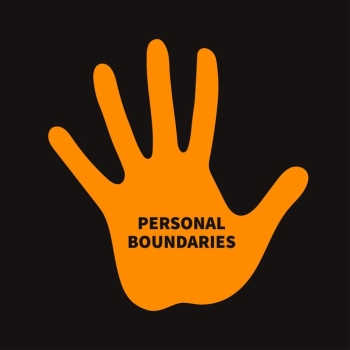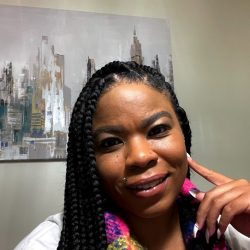
Identifying Your Boundaries: Boundaries are “guidelines, rules or limits that a person creates to identify for him- or herself that are reasonable, safe and permissible ways for other people to behave around him or her and how he or she will respond when someone steps outside those limits.” In a more practical sense, boundaries are the emotional and behavioral limits we place on our environment and others around us that we do not want to be crossed. Boundaries help keep us safe emotional and physically. Naturally, since boundaries are meant to protect us, we have to share them with others. Before you can express your boundaries, you have to know what they are. Don’t be alarmed if you feel like you have no idea what’s ok and what’s not ok for others to do and say around you or if you just take life as it comes. Most people don’t know their boundaries until they are crossed and feelings get hurt. This tip is designed to help you identify your own personal boundaries.
IDENTIFYING YOUR BOUNDARIES
Boundaries are an external representation of your personal values. You will have different boundaries in different situations based upon your own individual values and society’s norms. If you repeatedly find yourself in situations with people who make you feel uncomfortable, stressed, anxious, depressed, mad, or frustrated you need to set stricter boundaries. When people do or say things that trigger an intense emotional reaction within us, it is a signal that they have crossed a boundary. Most people cross a boundary accidentally because they didn’t know it existed. In fact, you may be completely unaware of your own boundaries, especially if no one has crossed them recently. Identifying where you need more space, self-respect, energy, or personal power is the first step to setting and maintaining appropriate boundaries. To get a sense of your own personal boundaries, start by answering the following questions:
- Are there any individuals make you feel insecure, hurt, frustrated, sad, or angry after spending time with them?
- What do your typical interactions with these people look like?
- What have you done in the past to control the situation?
- What’s worked and what hasn’t?
- What behaviors or actions would you like people to stop directing at you?
- What statements do you wish people would no longer say to you?
- What things do people say to you that undermine your confidence or self-esteem?
- Do people at your job make you feel pressure to engage in office politics or gossip that you feel interferes with work?
- Do friends assume you’re comfortable with certain topics that you’re not?
- When certain people ask for favors, does it leave you feeling overwhelmed?
- What things do people say about others that make you feel uncomfortable?
- Are there things you feel uncomfortable sharing with others?
- Do you feel the need to behave differently with different social groups?
- Do you feel pressure to engage in activities that you don’t want to do?
- What situations make you feel attacked or defensive?
- Who do you feel confident asserting a need with?
- Who do you feel would disrespect your personal space and values?
- What situations can you be most flexible with?
- What situations do you need to be guarded during?
- What has happened in the past that makes these people, behaviors, or situations uncomfortable?
- What do you want to prevent from happening in the future?
Using these questions as a guide, you will be able to identify times in your life when someone has made you feel uncomfortable. Feeling uncomfortable in work, school, family, dating, and social situations is a sign that your boundaries have been crossed. As you identify the discomfort, you are labeling a boundary. Your boundary is the point of the situation right before you felt uncomfortable. In the future, you will want to set boundaries with friends, family members, co-workers, and partners in order prevent the interactions from becoming uncomfortable. Keep in mind that you may not always notice an intense emotional reaction; sometimes the emotions are more subtle. Therefore, to identify your boundaries, you’ll want to pay close attention to the situations where you feel zapped of energy, get a knot in your stomach, or want to cry. By looking back on your interactions with others you will be able to see actions, words, and situations you don’t want to have to deal with again. This will help you develop ideas about what is ok for future interactions and what isn’t.
Once you have answered the questions and developed an awareness of times in the past when your unidentified boundaries have been crossed, you can formulate sentences that will express your boundaries in the future. To identify the statements that will become your boundaries, fill in the following sentences with 3 or more answers. People may not _________. You might answer this statement with: use me as a way to alleviate their anger or frustrations, gossip about others near me, search my office/purse/room/personal belongings, or touch me unless I say it’s ok. I have the right to ask for ___________. You may wish to ask for privacy, assistance with housework, quiet time alone, or clarification of a criticism. To protect myself it is ok for me to ___________. Boundaries you may place to protect yourself may include: turning off your cell phone/e-mail after a certain hour, changing your mind, or creating private space within your home. To prevent anxiety or depression I need __________. These needs may look like: less responsibility at work, more time talking with your partner, an hour with no kids, or positive reinforcement or validation.
Take the answers from your questions and the examples above as guidelines for developing your own boundaries. Use the answers about past situations to gain comprehension of what words, actions, topics, people, places, events, and situations you don’t want to repeat because of the negative impact the had on your well being. Then formulate the sentences above to make clear and concise boundaries you can express to others. Don’t be alarmed if you’re still not one hundred percent certain that your boundaries are “correct.” Identifying and setting boundaries is not about being right or wrong; it’s about developing a self-awareness of your needs and then expressing those needs, in the form of boundaries, to others. In this moment, your primary goal is to look back, gain insight into what has been hurtful in the past, and develop needs statements you can communicate in the future to prevent further harm.
At TCFG you can schedule directly online with a therapist. If you prefer talking to a therapist first, you may call (215) 922-LOVE (5683) ext 100 to be connected with our intake department. Lastly, you can call our Director, “Alex” Caroline Robboy, CAS, MSW, LCSW at (267) 324–9564 to discuss your particular situation. For your convenience, we have six physical therapy offices and can also provide counseling and therapy virtually.
- Ocean City Therapy Office
360 West Ave, Floor 1, Ocean City, NJ 08226 - Mechanicsville Therapy Office
9044 Mann Drive, Mechanicsville Virginia, 23116 - Providence Therapy Office
173 Waterman St. Providence, RI 02906 - Society Hill Therapy Office
233 S. 6th Street, C-33, Philadelphia PA 19106 - Art Museum / Fairmount Therapy Office
2401 Pennsylvania Ave, Suite 1a2, Philadelphia PA 19130 - Santa Fe Therapy Office, 2204 B Brothers Road, Santa Fe, New Mexico, 87505
- Telemedicine: We have therapists who are licensed to work in Connecticut, Florida, Georgia, New Jersey, New Mexico, Pennsylvania, Rhode Island, and Virginia.
OUR GUARANTEE: you deserve the best loneliness therapist. If you don't feel like the therapist that you met with was the right fit, then free of charge you can try out a different therapist. Being in a group practices allows for flexibility.
The Center for Growth has offices in multiple states. We offer both Couples Counseling and Marriage Therapy in person as well as virtual appointments.
The Center for Growth Therapy Offices in PA, NJ, VA, RI, NM, CT
Therapy Services Offered in Philadelphia, Ocean City, Mechanicsville, Providence, Santa Fe:
Individual Counseling and therapy
Couples Counseling and marriage counseling
Teen Therapy and Adolescent Therapy and tweens and child counseling
Family Therapy and multi-generational counseling
Art Therapy and Counseling no art skills needed
ADHD Therapyand ADD, Dyslexia, Autism, Tourettes counseling
Anxiety, Panic, OCD Therapy and worry and fear support
Breaking the cycle of Codependency and being your own person
Overcoming Chronic Illness and Chronic Pain .
Depression Therapy and sadness, gloom, and upset support
- Functional Neurological Disorder (FND) Therapy is a particular style of therapy designed for people with problems affecting their nervous system, how the brain and body send and receive signals.
Grief Therapy and loss, End of A Relationship, rejections, pregnancy and loss and therapy
Mindfulness Based Therapy and spirituality based therapy
- Narcissistic Abuse Recovery child of, parent of, spouse of, sibling of a narcissist.
Sex Therapy and sexual function & dysfunction, sex addiction, sexual orientation and gender identity support
Shame and Blame
Trauma Therapy both emotional and sexual abuse, complex trauma, PTSD counseling
Divorce support
Affairs, Infidelity, Unfaithful, Cheating counseling
Parenting therapy Parenting therapy
Personality disorder therapy Personality disorder treatments
Anger Management Therapy anger therapy
Setting Boundaries and identifying ones own Core Beliefs
Just name some of the Mental Health issues that we work with. Our goal is to help you Change and Achieve Your Dreams
Finding a therapist who focus on boundaries: Therapists who focus on boundaries often specialize in helping individuals establish and maintain healthy emotional, physical, and interpersonal boundaries. Setting and maintaining boundaries is crucial for maintaining mental and emotional well-being, fostering healthy relationships, and preventing issues like burnout, codependency, and resentment.
Therapists who specialize in boundaries may use various therapeutic approaches, including but not limited to:
- Cognitive-Behavioral Therapy (CBT): Therapists using CBT techniques help clients identify negative thought patterns and behaviors that lead to poor boundary-setting. Clients learn to replace these patterns with healthier alternatives.
- Dialectical Behavior Therapy (DBT): DBT focuses on building skills for emotional regulation, distress tolerance, interpersonal effectiveness, and mindfulness. These skills can help individuals set and maintain boundaries effectively.
- Gestalt Therapy: This approach emphasizes self-awareness and personal responsibility. Therapists help clients recognize when their boundaries are being crossed and teach them how to communicate assertively.
- Psychodynamic Therapy: Psychodynamic therapists explore the underlying unconscious factors that might contribute to boundary difficulties. This can involve delving into past experiences and their impact on current behaviors.
- Narrative Therapy: Therapists using narrative therapy help clients reframe their personal stories and identities, which can lead to a stronger sense of self and better boundary-setting.
- Solution-Focused Brief Therapy: This approach focuses on solutions and goal-setting. Therapists help clients identify what they want to achieve in terms of boundary-setting and work towards those goals.
- Family Systems Therapy: This approach examines how family dynamics and roles can affect an individual's ability to set and maintain boundaries. Therapists may work with families to improve communication and boundaries within the system.
- Mindfulness-Based Therapy: Mindfulness techniques can help individuals become more aware of their thoughts, emotions, and physical sensations, enabling them to make conscious choices about their boundaries.
When seeking a therapist who specializes in boundaries, consider the following steps:
- Research: Look for therapists who mention boundary work, assertiveness, or related concepts on their websites or profiles.
- Specializations: Some therapists explicitly mention their specialization in areas like boundary-setting, codependency, or healthy relationships.
- Credentials: Ensure that the therapist is licensed and credentialed in your region.
- Consultation: Many therapists offer a free initial consultation. Use this time to discuss your concerns and see if their approach aligns with your needs.
- Client Reviews: Reading client reviews or testimonials can provide insights into how a therapist has helped others with boundary-related issues.
- Personal Fit: It's important to find a therapist you feel comfortable with, as building a trusting therapeutic relationship is essential for the success of the therapy.
Remember that the process of setting and maintaining boundaries is a journey that takes time and effort. A therapist specializing in boundaries can provide you with the guidance, tools, and support needed to make positive changes in this aspect of your life.
























